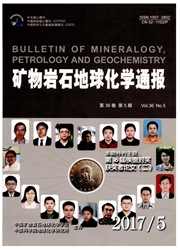

 中文摘要:
中文摘要:
从1979年提出“A型花岗岩”至今的30余年中,A型花岗岩被越来越多的学者认识并接受。但随对其研究的不断深入,A型花岗岩这个词被应用得太过广泛,以至于人们对它的认识变得越来模糊不清。Frost等人根据铁镁指数指出“A型花岗岩”是铁质的花岗岩,并基于铝饱和指数、碱度指数以及修正的Peacock碱钙指数将铁质花岗岩类划分为过碱质、过铝质和准铝质3个成分组和8个亚类。铁质花岗岩的厘定并不需要微量元素和同位素地球化学依据,作为描述性的术语,“铁质花岗岩”名称本身不具有特定的岩石成因意义。但是,铁质花岗岩的主要岩石化学特点与其成因机制之间具有隐含的密切联系。不同的成岩过程演化出多样的铁质花岗岩,某种程度上,此分类方案深刻地反映了铁质花岗岩多样性的本质。
 英文摘要:
英文摘要:
It has been more than 30 years since the term "A-type granite" was defined in 1979, more and more gran- ites were referred to as A-type granite. However, the term "A-type granite" has become more confusing than edif- ying because it has been applied to a broad spectrum of granitoid compositions with varying petrogenesis. Frost et al. and Frost et al. defined that A-type granitoids are ferroan granitoids as their distinguished Fe-index (Fe * ) val- ues in the Fe * vs. SiO2 diagram. The ferroan granitoids are subdivided into 3 groups according to the aluminum saturation index and the alkalinity index that including peralkaline, metaluminous and peraluminous granitoids, and categorized into 8 subclasses further on the basis of the modified alkali-lime index. Importantly, the concept of fer- roan granitoid is non-genetic, thus the evidences of trace elements or isotopes are needless essentially for its defini- tion. However, the major elements characteristics of the ferroan granitoids are significantly influenced by petroge- netic processes. As a result, the ferroan granitoids can originate from distinct petrogenetic processes. In this sense, the new classification proposed by Frost et al. reveals the essence of the variety of ferroan (A type) granitoids.
 同期刊论文项目
同期刊论文项目
 同项目期刊论文
同项目期刊论文
 期刊信息
期刊信息
